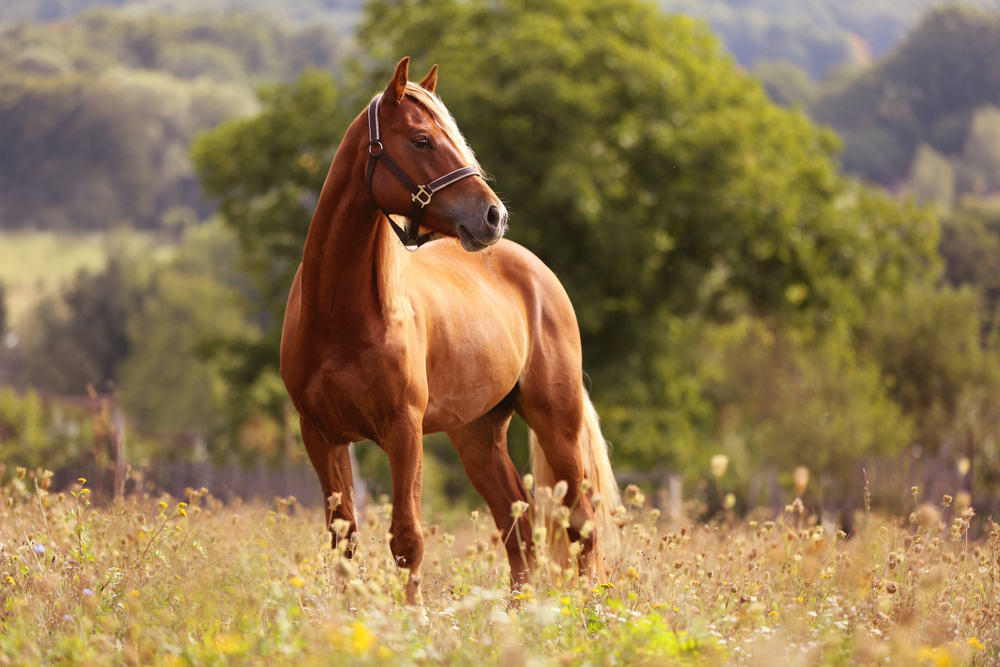Have you ever heard of moon blindness? No, it isn’t the latest Halloween craze, but rather another name for equine recurrent uveitis (ERU), the leading cause of blindness in horses worldwide. Uveitis refers to an inflammation of one of the layers lining the back of the eye, and the recurrent designation indicates that the horse has experienced two or more separate bouts of uveitis. Horses can also have an isolated uveitis episode, recover, and never suffer the disease again. The outlook for a single uveitis occurrence is considerably more favorable than for ERU, but horse-lovers must be aware of both variants.
Why does uveitis occur in horses?
Blunt or penetrating eye trauma, corneal ulcers, cancer, or infectious diseases can all cause a uveitis episode. Most ERU cases are immune-mediated, and occur when the barrier that normally keeps cells out of the eye is permanently disrupted, allowing white blood cells to enter the eye and release inflammatory products. Leptospirosis, a bacterial infection, is one of the leading ERU triggers, although chronic inflammation from other causes and genetic susceptibility may also play a role.
Are some horses more prone to ERU than others?
ERU can occur in any horse breed, age, or gender, but is more commonly seen in middle-aged Appaloosas, draft breeds, warmbloods, Quarter Horses, and Thoroughbreds. Appaloosas are eight times more likely to develop ERU and four times more likely to become blind compared with other horses, and a link to the leopard pattern has been proposed. The University of Minnesota College of Veterinary Medicine is currently studying the genetics of ERU in Appaloosas in hopes of developing a genetic test and better understanding the disease.
If my horse has ERU in one eye, will they likely have it in the other eye?
In Appaloosas, 80% to 85% of ERU cases occur in both eyes, but in other horses, that number drops to 50%.
What are the consequences of ERU?
Ongoing eye inflammation, cataracts, retinal detachment, or other ERU-related consequences cause blindness in 56% of horses, and affected horses are also more prone to painful glaucoma (i.e., increased intraocular pressure). Because of eye changes and vision concerns, 60% of affected horses can no longer perform at the same level.
What are some uveitis signs in horses?
During a flare of some ERU types, or a solitary uveitis episode, your horse may show these signs:
- Cloudy cornea
- Hazy appearance to the inner eye
- Squinting or holding the eye closed
- Light sensitivity
- Eye pain
- Constricted pupil
- Eye discharge
Never use left-over medications to treat a suspected new uveitis or a flare of your horse’s existing ERU without consulting our Veterinary Vision Center team first. Corneal ulcers, eye trauma, or foreign material in the eye may also cause these signs, and could worsen if erroneously treated with ERU medications.
Because of smoldering ongoing damage from ERU, your horse may also exhibit more subtle changes, such as:
- Cataract formation
- Eye color change
- Misshapen pupil
- Reduced or absent vision
- Shrunken or wrinkled eye appearance
How will my horse be diagnosed with uveitis?
Dr. Pierce, our board-certified veterinary ophthalmologist, can diagnosis uveitis using the following assessments:
- Ocular exam — Dr. Pierce will use a handheld microscope to magnify the front of the eye, apply fluorescein stain to check for corneal ulcers, measure the intraocular pressure, assess your horse’s vision, and use dilating drops and special lenses to view the back of the eye. Abnormalities in these tests can help confirm his suspicion that your horse has uveitis.
- Bloodwork — Dr. Pierce may order a complete blood count and chemistry panel to look for underlying disease signs.
- Leptospirosis testing — In some cases, Dr. Pierce will test your horse for leptospirosis exposure, a leading ERU trigger.
What can be done to treat uveitis and ERU?

Uveitis treatment relies heavily on topical or systemic steroids and non-steroidal anti-inflammatories to reduce eye inflammation. Horses also benefit from a medication to dilate the pupil and decrease the chances of adhesions forming between eye structures, and antibiotics may be used to manage confirmed leptospirosis cases. A solitary uveitis case is likely to resolve with treatment, but horses with ERU often require ongoing therapy to control their pain, decrease the inflammation, and maintain their vision as long as possible. Some horses benefit from an intraocular device that controls ERU for several years by releasing the drug cyclosporine, which calms the eye’s inappropriate immune response. Once Dr. Pierce diagnoses your horse with uveitis or ERU, he will work with you to find the right course of treatment.
If your horse is experiencing uveitis, ERU, or any other problem, don’t hesitate to contact Veterinary Vision Center, where your horse’s comfort and sight are our top priority.







Leave A Comment